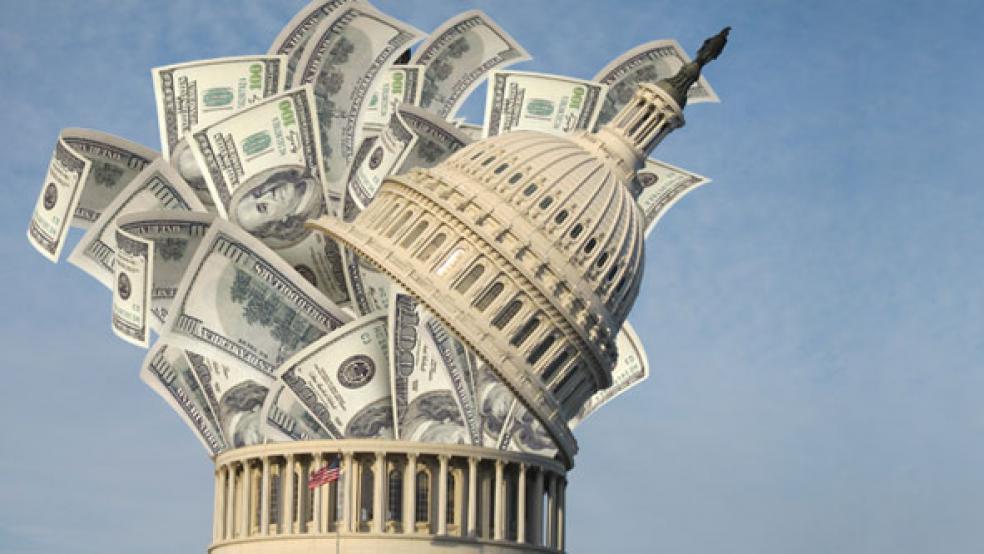Federal spending should exceed $3.6 trillion next year—and Democrats and Republicans are ready for a budget fight that will likely go down to the penny. 
Congress is returning after having voted last week to temporarily reopen the government and set up a bipartisan committee for talks on a broader deal.
RELATED: MEET THE PLAYERS FOR THE 2014 FISCAL FINALS
The heads of each chamber’s budget committee, Sen. Patty Murray (D-WA) and Rep. Paul Ryan (R-WI), and 27 of their colleagues will try to patch together a compromise that finally stops the past few years of governance through crisis.
President Obama will be another force in the conversation, even if the new conference committee only consists of members of the Senate and the House. All three groups have ideas of their own.
The White House proposed a budget that trims entitlement spending, the House passed one that balanced by quashing Obamacare spending, and the Senate approved a budget that raised an additional $973 billion in tax revenues over 10 years.
None of these individual budget plans have a chance of becoming law of the land. However, they each contain nuggets of policies that could shape any final deal that must be reached by Dec. 13.
Can Medicare Be Cut? – The big obstacle is whether the committee can agree to curb costs for this health care entitlement program.
Because Medicare helps senior citizens, it is considered to be politically untouchable … even though baby boomer retirements make it a primary source of escalating deficits in the coming decades. Republicans don’t want to alienate their older base, while Democrats cannot afford to upset labor unions.
RELATED: OBAMA CUTS SOCIAL SECURITY, MEDICARE FOR MORE TAXES
“No politician… I don’t care the political party… will get away with cutting Social Security, Medicare or Medicaid benefits,” AFL CIO president Richard Trumka said in a Monday speech. “Don’t try it. And this warning goes double for Democrats. We will never forget. We will never forgive. And we will never stop working to end your career.”
But the committee does have two possible options.
Obama’s budget identified $371 billion in savings over ten years, which would be used to reduce the automatic cuts in budget sequestration.
His plan increased deductible costs for new beneficiaries starting in 2017, cause wealthier beneficiaries to pay more in premiums, reduce funding to hospitals for uncollected debts and graduate medical education, and acquire drugs at cheaper prices for low-income beneficiaries.
Outside of the budget plan, White House negotiators have also floated the idea of using a less generous measure of inflation known as chained CPI to limit the growth of entitlement programs.
RELATED: 5 BIG IMPACTS FROM CHAINED CPI
The Republican budget plan is much more ambitious. It would raise the eligibility age from 65-years old by two months with each passing year until it reached 67 in 2024, generating almost $130 billion in savings over the next decade.
The blueprint would also transform Medicare into a voucher-style program in 2024 for all new beneficiaries that Ryan calls “premium support.”
Under this system, the government would provide a baseline subsidy for Medicare recipients to buy health insurance through a special exchange, a plan that sounds remarkably similar to the broad outlines of Obamacare—a program that Republicans want to eliminate. The criticism among Democrats of this approach is that it could simply shift more health care costs onto seniors.
Both the administration and Republicans also have an incentive to limit Medicare benefits for wealthier Americans, since neither side sees a reason to protect the rich.
“It is, obviously, sort of one of the few pieces of common ground that we have,” Ryan said last April.
Discretionary Spending – Because lawmakers can’t agree on how to reduce entitlements, they instead applied cuts to roughly the roughly $1 trillion a year discretionary budget—which funds the military, food stamps, education, and a host of other basic programs.
The 2011 Budget Control Act introduced the sequester, which going forward would automatically trims non-defense and military programs by $718 billion through 2021.
RELATED: THE SEQUESTER—WHAT IN THE WORLD IS IT?
Senate Democrats want to devote $1.058 trillion to the discretionary side for 2014, while House Republicans want to spend $91 billion less, or $967 billion.
Essentially, the battle is over whether to preserve the sequester or shift more money into discretionary spending to stimulate the economy. For example, the Obama budget would invest $50 billion in infrastructure projects such as highways, railways, bridges and airports. Senate Democrats want $100 billion for infrastructure and job training.
Senate Minority Leader Mitch McConnell (R-KY) pledged to preserve the sequester, but Republicans also have a reason to reach a deal on discretionary spending. Because the cuts in their budget blueprint are so deep, House Republicans could not pass this summer appropriations measures for the Transportation Department and the Housing and Urban Development Department.
Taxes – House Republicans refuse on principle to increase the amount of tax revenues collected, even though both parties favor simplifying the tax code.
GOP congressmen voted to collect about $3 trillion in tax revenues in 2014—the same level that was projected by the Congressional Budget Office. The GOP would like to drop income tax rates to two brackets of 10 percent and 25 percent, while eliminating tax breaks so that revenues remained steady.
The Tax Policy Center estimated that the GOP would have to identify $5.7 trillion of tax breaks over 10 years—or $539 billion a year—to eliminate. The Washington-based think tank concluded in March that “it is hard to imagine” finding loopholes large enough to close to generate this income.
Senate Democrats want to tack $19 billion onto that for 2014—and a total of $975 billion over ten years primarily by limiting deductions for wealthier Americans and closing loopholes. The Obama budget seeks an additional $580 billion in taxes over the next decade by restricting deductions for better-off Americans.
It’s critical to note that both sides want to trim the tax code, with Democrats looking for almost $1 trillion of deductions to remove and Republicans seeking $5.7 trillion. Where they differ is whether to keep rates at the same level, or slash them.
Republicans have no interest in any policy that causes more revenues to flow to the government.
“Tax reform as a principle, absolutely, we’d love to get that done,” said McConnell spokesman Don Stewart. “The problem is that the Democrat ransom for that is a trillion dollars, and we’re not interested in paying a trillion dollar ransom to get tax reform.”
The Fiscal Times Washington Editor Eric Pianin contributed to this piece.




